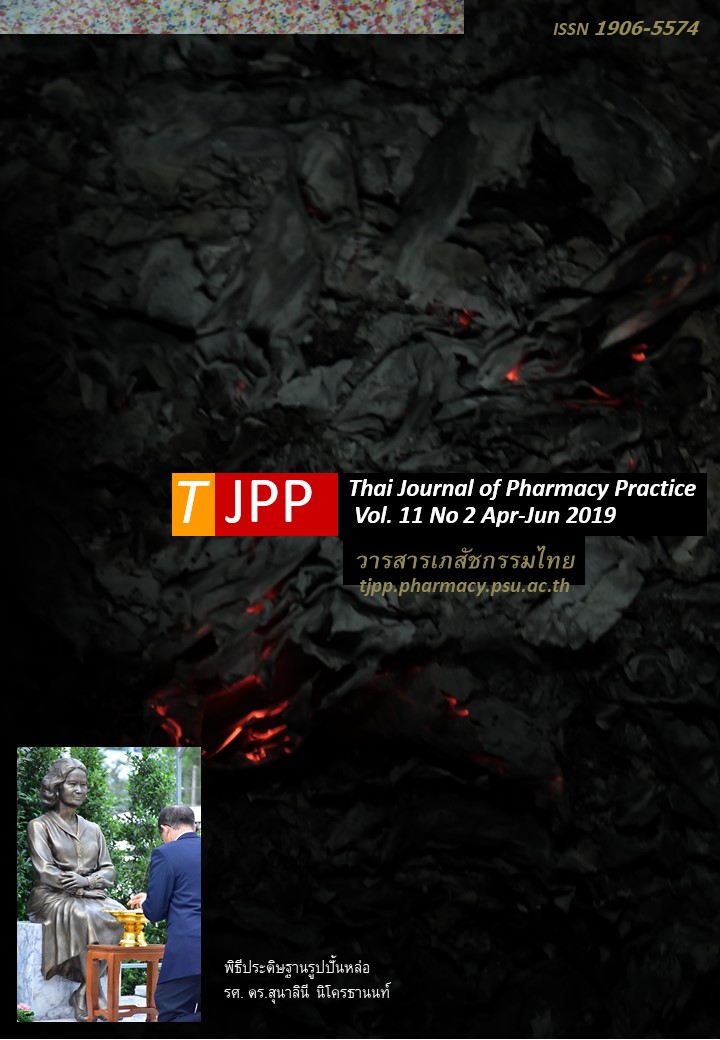ภาวะบกพร่องทางระบบประสาทอัตโนมัติในผู้ป่วยโรคพาร์กินสัน
Main Article Content
บทคัดย่อ
วัตถุประสงค์: เพื่อศึกษาลักษณะทางคลินิกของภาวะบกพร่องทางระบบประสาทอัตโนมัติ (autonomic dysfunction หรือ AD) ในผู้ป่วยโรคพาร์กินสัน (Parkinson’s disease: PD) และเปรียบเทียบจำนวน AD ในผู้ป่วย PD ที่มีปัจจัยส่วนบุคคล ความรุนแรงของโรค และยาที่แตกต่างกัน วิธีการ: การวิจัยนี้เป็นการศึกษาแบบภาคตัดขวางในผู้ป่วย PD 93 คน ที่ผ่านเกณฑ์การคัดเข้างานวิจัยระหว่างเดือนกันยายน-ตุลาคม 2559 และเข้ารับการรักษาที่แผนกผู้ป่วยนอก ณ ศูนย์ความเป็นเลิศทางการแพทย์โรคพาร์กินสันและกลุ่มโรคความเคลื่อนไหวผิดปกติ โรงพยาบาลจุฬาลงกรณ์ ผู้วิจัยสัมภาษณ์ผู้ป่วยด้วยแบบประเมิน Thammasat University Non-Motor Symptoms Questionnaire (TU-NMSQuest) เพื่อประเมินการเกิดภาวะ AD ได้แก่ ปัญหาระบบทางเดินอาหาร ปัญหาระบบทางเดินปัสสาวะ ปัญหาระบบหัวใจและหลอดเลือดและการหกล้ม และปัญหาทางเพศสัมพันธ์ ผลการวิจัย: ภาวะ AD ที่พบ คือ ปัญหาระบบทางเดินอาหาร (ร้อยละ 88.17 ของตัวอย่าง) ปัญหาระบบทางเดินปัสสาวะ (ร้อยละ 59.14 ของตัวอย่าง) ปัญหาระบบหัวใจและหลอดเลือดและการหกล้ม (ร้อยละ 54.84 ของตัวอย่าง) และปัญหาทางเพศสัมพันธ์ (ร้อยละ 16.13 ของตัวอย่าง) ลักษณะทางคลินิกที่สัมพันธ์กับการมีภาวะ AD ที่เกี่ยวกับระบบทางเดินอาหาร คือ อายุที่มากกว่าและความรุนแรงของโรค PD ที่มากกว่า (มี Hoehn & Yahr stage ที่สูงกว่า) ภาวะ AD ที่เกี่ยวกับระบบทางเดินปัสสาวะมีความสัมพันธ์กับอายุที่มากและอายุที่เริ่มเป็นโรค PD ที่มากกว่า ภาวะ AD ที่เกี่ยวกับเพศสัมพันธ์มีความสัมพันธ์กับอายุและอายุที่เริ่มเป็นโรค PD ที่น้อยกว่า การวิเคราะห์ความแปรปรวนแบบทางเดียวไม่พบว่ามีตัวแปรใดที่สัมพันธ์กับจำนวนของภาวะ AD สรุป: ภาวะ AD พบได้สูงในผู้ป่วย PD ปัจจัยที่สัมพันธ์กับการมีภาวะ AD ในระบบทางเดินอาหารและระบบทางเดินปัสสาวะ คือ อายุที่มากกว่า Hoehn & Yahr stage ที่สุงกว่า และอายุที่เริ่มเป็น PD ที่มากกว่า ขณะที่ผู้ป่วยที่มีปัญหาทางเพศสัมพันธ์มีอายุและอายุที่เริ่มเป็น PD ที่น้อยกว่า อย่างไรก็ตามไม่พบว่ามีตัวแปรใดที่สัมพันธ์กับจำนวน AD
Article Details
ผลการวิจัยและความคิดเห็นที่ปรากฏในบทความถือเป็นความคิดเห็นและอยู่ในความรับผิดชอบของผู้นิพนธ์ มิใช่ความเห็นหรือความรับผิดชอบของกองบรรณาธิการ หรือคณะเภสัชศาสตร์ มหาวิทยาลัยสงขลานครินทร์ ทั้งนี้ไม่รวมความผิดพลาดอันเกิดจากการพิมพ์ บทความที่ได้รับการเผยแพร่โดยวารสารเภสัชกรรมไทยถือเป็นสิทธิ์ของวารสารฯ
เอกสารอ้างอิง
2. Bhidayasiri R, Wannachai N, Limpabandhu S, Choeytim S, Suchonwanich Y, Tananyakul S, et al. A national registry to determine the distribution and prevalence of Parkinson’s disease in Thailand: implications of urbanization and pesticides as risk factors for Parkinson’s disease. Neuroepidemiology 2011; 37: 222-30.
3. Bhidayasiria R, Truong DD. Therapeutic strategies for nonmotor symptoms in early Parkinson’s dis ease: the case for a higher priority and stronger evidence. Parkinsonism Relat Disord 2012; 18: S 110 -3.
4. Martinez-Martin P, Rodriguez-Blazquez C, Kurtis MM, Chaudhuri KR. The impact of non-motor symptoms on health-related quality of life of patients with Parkinson’sdisease. Mov Disord 2011; 26: 399 –406.
5. Barone P, Antonini A, Colosimo C, Marconi R, Morgante L, Arvarello TP, et al. The PRIAMO study: a multicenter assessment of nonmotor symptoms and their impact on quality of life in Parkinson’s disease. Mov Disord 2009; 24: 1641–9.
6. Dickson DW, Fujishiro H, Orr C, DelleDonne A, Josephs KA, Frigerio R, et al. Neuropathology of non-motor features of Parkinson disease. Parkinso nism Relat Disord 2009; 15: S1-5.
7. Velseboer DC, Haan RJd, Wieling W, Goldstein DS, de Bie RM. Prevalence of orthostatic hypoten sion in Parkinson's disease: a systematic review & meta-analysis. Parkinsonism Relat Disord 2011; 17: 724-9.
8. Shaw BH, Claydon VE. The relationship between orthostatic hypotension and falling in older adults. Clin Auton Res 2014; 24: 3-13.
9. Isaacson SH, Skettini J. Neurogenic orthostatic hypotension in Parkinson’s disease: evaluation, management, and emerging role of droxidopa. Vasc Health Risk Manag 2014; 10: 169-76.
10. Sithinamsuwan P, Orrawanhanothai P, Thithum K, Udommongkol C, Chairangsaris P, Chinvarun Y, et al. Orthostatic hypotension: a non-motor compli cation assessment in 82 patients with idiopathic Parkinson’s disease in Phramongkutklao Hospital. J Med Assoc Thai. 2010; 93: S93-9.
11. Klanbut S, Phattanarudee S, Wongwiwatthana nukit S, Suthisisang C, Bhidayasiri R. Symptomatic orthostatic hypotension in Parkinson's disease patients: prevalence, associated factors and its impact on balance confidence. J Neurol Sci 2018; 385: 168-74.
12. Pfeiffer RF. Gastrointestinal dysfunction in Parkin son's disease. Parkinsonism Relat Disord 2011; 17: 10-5.
13. Chaudhuri KR, Martinez-Martin P, Schapira AH, Stocchi F, Sethi K, Odin P, et al. International multicenter pilot study of the first comprehensive self-completed nonmotor symptoms questionnaire for Parkinson's disease: the NMSQuest study. Mov Disord 2006; 21: 916-23.
14. Crosiers D, Pickut B, Theuns J, Deyn PP, Van Broeckhoven C, Martinez-Martin P, et al. Non-motor symptoms in a Flanders-Belgian population of 215 Parkinson's disease patients as assessed by the non-motor symptoms questionnaire. Am J Neurode gener Dis 2012; 1: 160-7.
15. Blackett H, Walker R, Wood B. Urinary dysfunc tion in Parkinson's disease: a review. Parkinsonism Relat Disord 2009; 15: 81-7.
16. Lolekha P, Kulkantrakorn K. Non-motor symptoms in Thai Parkinson’s disease patients: prevalence, manifestation and health related quality of life. Neuro Asia. 2014; 19: 163-70.
17. Tomlinson CL, Stowe R, Patel S, Rick C, Gray R, Clarke CE. Systematic review of levodopa dose equivalency reporting in Parkinson’s disease. Mov Disord 2010; 25: 2649-85.
18. Vongvaivanich K, Nidhinandana S, Udommong kol C, Chairungsaris P, Chinvarun Y, Wongmek W, et al. Non-motor symptoms in Thai patients with Parkinson's disease studied at Phramongkutklao Hospital. J Med Assoc Thai 2014; 97: S159-67.
19. Sauerbier A, Jitkritsadakul O, Titova N, Klingelho efer L, Tsuboi Y, Carr H, et al. Non-motor symp toms assessed by non-motor symptoms question naire and non-motor symptoms scale in Parkinson 's disease in selected Asian populations. Neuroepide miology. 2017; 49: 1-17.
20. Bae HJ, Cheon SM, Kim JW. Autonomic dysfunc tions in parkinsonian disorders. J Mov Disord 2009; 2: 72-7.
21. Senard JM, Raï S, Lapeyre-Mestre M, Brefel C, Rascol O, Rascol A, et al. Prevalence of orthostatic hypotension in Parkinson’s disease. J Neurol Neu rosurg Psychiatry 1997; 63: 584-9.
22. Uchiyama T, Sakakibara R, Hattori T, Yamanishi T. Short-term effect of a single levodopa dose on micturition disturbance in Parkinson's disease patients with the wearing-off phenomenon. Mov Disord 2003; 18: 573-8.
23. Fasano A, Visanji NP, Liu LW, Lang AE, Pfeiffer RF. Gastrointestinal dysfunction in Parkinson's disease. Lancet Neurol 2015; 14: 625-39.
24. Klingelhoefer L, Jitkritsadakul O, Bhidayasiri R. Objective measurement and monitoring of non motor symptoms in Parkinson's disease. Int Rev Neurobiol 2017;133: 347-87.
25. Okun MS, Walter BL, McDonald WM, Tenover JL, Green J, Juncos JL, et al. Beneficial effects of testosterone replacement for the nonmotor symp toms of Parkinson disease. Arch Neurol 2002; 59: 1750-3.
26. Vilas D, Pont-Sunyer C, Tolosa E. Impulse control disorders in Parkinson's disease. Parkinsonism Relat Disord. 2012; 18: S80-4.


